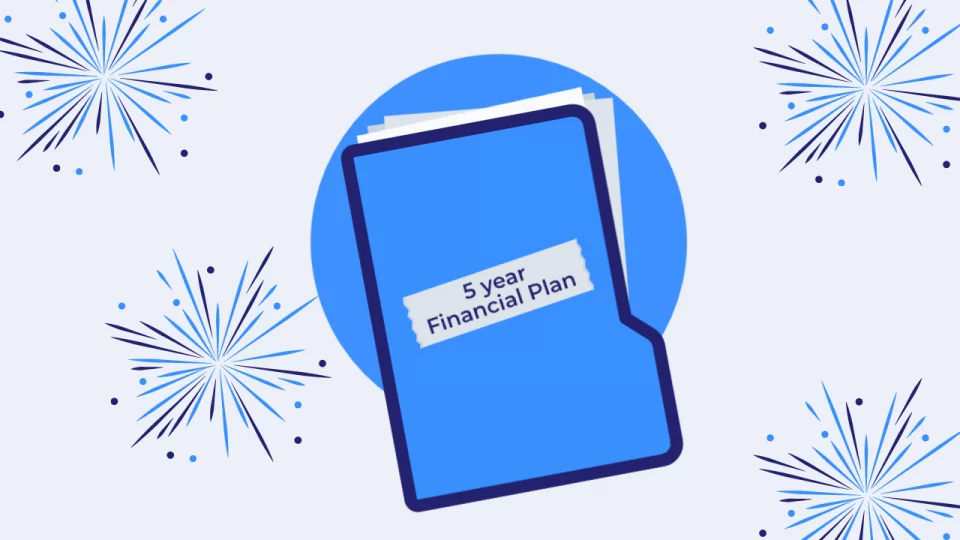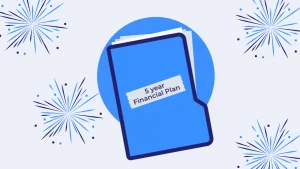May 04, 2022

Pocketnest
Jan. 4, 2022
 A five-year financial plan—what is it? How does it work? Who really needs one? Is there a certain age by which you should have one? All great questions!
A five-year financial plan—what is it? How does it work? Who really needs one? Is there a certain age by which you should have one? All great questions!
Creating a five-year financial plan will help you stay on track with your finances for the next five years of your life, as you navigate new financial wins and struggles, new jobs, and life milestones like partners, babies, houses, pets, and more. (Bet you could have guessed that!)
To make creating your five-year financial plan a bit easier on you (hey, we’ve all been through a lot this past year!), we’ve put together some tips and tricks to help you successfully create your own five-year financial plan.
Now, let’s get started on your financial plan!
People often say they set high goals because, otherwise, what’s the point? If you’re not reaching for the stars, they say, why bother reaching at all?
While “they” make some good points, we say to set realistic goals so you can reach them, celebrate, then reset them to be something harder. The point of setting goals is to actually reach them after all, right? For some of us, financial planning can feel hard enough as it is, so why not bake in a few wins for ourselves?!
While crafting your plan, remember that you are coming from your own unique financial standpoint. Your mom or your friend may have opinions on your goals, but remember that you are building your five-year financial plan for yourself. Not for your mom or your friends.
If you know you won’t be able to achieve the goal in the next five years, don’t include it. It doesn’t matter if your goals are as small as opening some small investments (See: 10 Investment Tips for 20-Somethings) or as big as a 20 percent down payment on a house (See: How Much House Can—No, Should!—You Afford?)—they’re your own unique goals that you can feel confident in achieving!
With the mindset of setting attainable goals, we recommend specificity when setting your intentions. Think of it this way: the more specific you make your goals, the more direction you’re giving yourself, and the easier it’ll be to measure your success toward your goals.
Instead of making broad, vague goals, set a value or a specific measurement. For example, instead of a goal of saving money for retirement, make a goal of putting a specific percentage of your income into your retirement account each month. (We recommend 15 percent of your income, if you can swing it after paying off “bad” debt. See: How Much Should I Save for Retirement?) Similarly, instead of saying you’ll pay off your credit card debt, allocate a certain percentage of your monthly leftover income to paying it off each month. (See: How to Pay Off Debt When Cash Is Tight.)
Yep! Commit yourself to your intentions and your goals in your financial plan. And, no, this shouldn’t just be a little voice in the back of your head. We actually mean to grab a pen and paper (or tablet or laptop, whatever) and write down (or type) your specific and attainable goal. Write down your plan in a Google Doc, in your Messages app, on a post-it note—anywhere that you will be able to easily find when you need it.
We highly recommend using the (FREE!) Pocketnest app as you build your plan. But, if you’re a pen and paper kinda person, we get it!
Now that you have an idea of where to start, and how to think about your goals and intentions, make sure you have the following essentials in your five-year plan:
Create a net worth snapshot. Before you know what you need, you need to know what you have, and where. Figure out how much money you have, in which accounts, and owed to which debts. From there, you can make goals for each bucket—e.g., debts, investments, savings, etc. (See: How to Create a Net Worth Snapshot.)
Establish an emergency fund. It’s important to have extra bucks set aside for emergency purposes, only. You never know when you’ll need new tires, a new roof, emergency surgery—you get it. (See: How to Create an Emergency Cash Reserve + When to Spend Your Emergency Fund.)
Build an investment portfolio. Investing a portion of your income can yield big returns. Remember that, while the markets can be volatile, they trend upward over time! Of course you’ll want to make sure you have your bad debt—like credit card debt—paid off before playing in the markets. (See: Investment Tips for 20-Somethings + How to Think About Your Investments During a Crisis.)
Pay off debt. Being able to pay off all, or at least a significant amount, of your outstanding debt will take an unbelievable weight off of your shoulders. (See: How to Pay Off Debt When Cash Is Tight + Should You Refinance Your Student Loans?)
Create a savings account. If you haven’t already done so, make sure you open a savings account. Take a certain amount of cash each month and put it into this account to help you save up over time.
*Insert goal here.* Don’t only have obvious goals like saving and investing in your plan? Make it specific to you and your situation! Maybe you want to start your own business, or add an extra source of income, or go back to school. The possibilities are endless. Choose one, write it down, and get cracking!
Great job! You’ve kickstarted your financial plan! Before you check it completely off your To Do lists, this isn’t a “set it and forget it” kind of deal. You’ll need to check in every few months to make sure you’re sticking to the goals you set for yourself. Do you need to recalibrate them? That’s okay!
Every five years, it’s a good idea to reset your financial plan. After all, your financial needs change over time, especially as you meet life milestones like houses, marriage, babies, new jobs, investments, college funds, and more. Stay on your financial plan and it will repay you exponentially! (See: Financial Planning Through the Decades.)
Don’t forget to download the Pocketnest app and achieve financial wellness—in just 3 minutes a week!